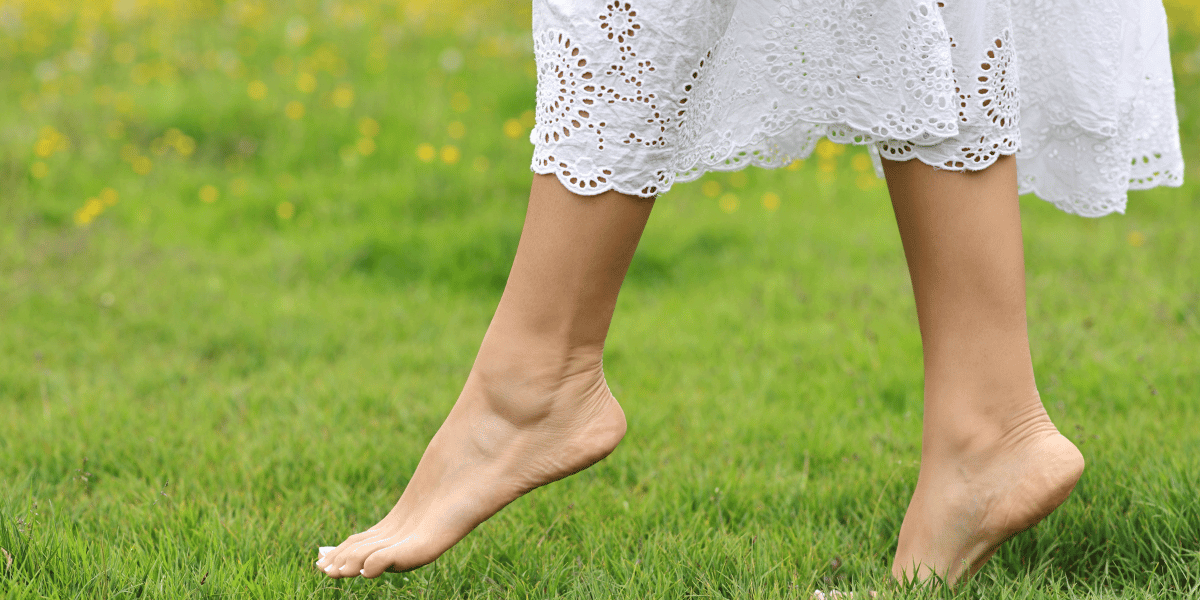Earthing (also called grounding) can be a controversial topic. Many report improved well-being and fantastic health benefits, including better sleep and less pain. However, critics emphasize the need for more solid scientific studies supporting this practice. Let’s delve into the evidence.
What is Earthing?
Earthing or grounding involves putting the body into direct and uninterrupted contact with the earth. This means the skin needs to touch soil, sand, water, or conductive material on the surface of the earth.
Clint Ober brought attention to the concept in 2010 with his book Earthing: The Most Important Health Discovery Ever! He discovered the benefits of getting grounded after his health declined after years of working as a cable installer. He knew the importance of grounding from his career and decided to apply this knowledge to his own body. He essentially pioneered the modern Earthing movement.
From a scientific perspective, the idea is that the earth has a mild negative charge. Over time, especially in modern life, our bodies build up a positive static electric charge. This positive charge creates oxidative stress in the body. Direct contact with the earth’s surface can even out this positive charge and return the body to a neutral state.
Unfortunately, most of us don’t have regular contact with the earth anymore. It’s leading some experts to wonder whether this contributes to today’s rising health problems. We wear rubber-soled shoes and live indoors so can go years without directly touching the earth.
When this positive charge builds up over time, it can lead to health problems. That’s where reconnecting to the earth through earthing mats or sheets comes in. Earthing products help us get grounded, which refers to connecting electrical devices to the earth for safety purposes.
What is Earthing vs Grounding?
Earthing and grounding are often used interchangeably, however they have subtle differences.
- Earthing refers to deliberately making physical contact with the Earth for health benefits.
- Grounding can refer to the electrical safety process or grounding our bodies.
You can ground indoors by using earthing products. Whether you’re walking barefoot outside or getting grounded inside, you’re essentially doing the same thing.
Earthing Science 101
Here’s a bit more on how it works:
Our bodies naturally produce free radicals. We need a certain amount of free radicals to attack and eliminate bacteria and viruses. They’re also involved in the inflammatory response, which is part of healing.
However, too many can contribute to chronic inflammation, leading to pain, chronic illnesses, and accelerated aging. While free radicals are necessary, having too many can be harmful.
These molecules can be damaging because they’re unstable and lack electrons. One way to stabilize or neutralize them is to supply the missing electrons by consuming antioxidants. Some natural sources include vitamins A, C, and E and polyphenols from green tea, cacao, pomegranate, etc.
However, our diet isn’t the only source of electrons–earthing can also help. When the body carries a positive charge, electrons flow into it. The Earth is an everflowing source of free electrons that can reduce excess free radical activity as well as inflammation. So, what does earthing do to the body?
What Does Grounding Do To the Body?
People often try earthing as a way to reduce pain, improve sleep, or speed healing. According to emerging research, earthing may help the following:
Reduce Inflammation
Because it combats oxidative stress, grounding can have powerful anti-inflammatory effects. As a result, it can reduce symptoms associated with inflammation, including:
- Reducing pain from injury
- Relieving muscle tension
- Lowering the frequency and severity of headaches and migraines (I noticed this)
- Reducing joint pain
- Reducing back and neck pain
These symptoms may be the most immediately noticeable. However, grounding regularly may improve symptoms of chronic inflammatory conditions over time.
A 2015 study confirmed that grounding reduced the five cardinal signs of inflammation (redness, heat, swelling, pain, and loss of function). It also lowered circulating chemical markers of inflammation.
Researchers found those with lupus and other autoimmune conditions benefitted greatly from grounding. Their immune systems calmed down, pain levels decreased, and they generally felt better.
Improve Sleep
I can vouch strongly for this! Earthing can support a restful night’s sleep in several ways:
- Lower stressful feelings
- Reduce high cortisol levels
- Normalize circadian rhythms
- Improve insomnia and other sleep disorders
- Reduce snoring
- Decrease inflammation and pain
Grounding at night noticeably changes day-night cortisol secretion, promoting a normal circadian rhythm. Those who grounded while sleeping had noticeable improvements in sleep, pain, and stress symptoms. While most of us don’t camp every night, earthing sheets or mats can help us stay grounded while sleeping indoors.
Earthing can also help when traveling. Those who travel across time zones report that earthing reduces jet lag and helps them align with the new local time.
Increase Energy (I Noticed This Also)
Earthing may increase energy levels by balancing the body’s electrical charge and reducing stress. It may help:
- Reduce internal stress and mental health issues
- Lower inflammation
- Support adrenal health
- Enhance blood flow and oxygenation
- Balance cortisol and hormones
- Improve sleep quality
- Restore electrical balance
Earthing may reduce chronic fatigue by lowering stress and inflammation and improving sleep. Improved oxygen delivery to blood cells can also improve energy levels.
Support Cardiovascular Health
Earthing may also support a healthy cardiovascular system. It’s known to reduce inflammation and stress levels, but it may also work through other pathways:
- Normalizing blood flow and blood pressure
- Reducing blood viscosity and risk of blood clots
- Lowering stress and cortisol levels
- Restoring electrical balance
- Normalizing Heart Rate Variability (HRV)
HRV measures the variation in time between heartbeats. It’s often used as a biomarker for heart health, as a higher HRV is linked to better cardiovascular fitness.
Support Hormone Balance
Earthing may help support women’s hormone balance by reducing stress, improving sleep, and influencing our natural rhythms. Here are some ways earthing might impact hormones:
- Lowering cortisol, which can interfere with estrogen and progesterone balance
- Improve biological rhythms like menstrual cycles
- Promote restful sleep, which impacts hormone balance
- Reduce inflammation and oxidative stress linked to estrogen dominance and other hormone conditions
- Take stress off the thyroid
Support Healing
Earthing supports a balanced nervous system. It helps take the body out of fight-or-flight and return it to rest and repair. That alone may help to speed healing and recovery. However, it may also work by:
- Lowering inflammation and oxidative stress
- Reducing pain by lowering inflammation
- Enhancing sleep quality
- Supporting a healthy immune response
- Improving circulation, improving the delivery of oxygen and nutrients to the damaged tissues
- Shortening recovery time from athletic activity, as it reduces delayed onset muscle soreness (or DOMS)
The Earthing Institute put together an extensive list of testimonials with conditions listed from A to Z.
Scientific Evidence for Earthing
This is where the controversy begins. Critics claim there isn’t any evidence to back up this practice and that it could even be dangerous. Proponents cite anecdotal evidence and a few small studies. So, who’s right?
A few small-scale studies looked at examined the effects of earthing or grounding. One study examined 60 people with chronic pain and sleep troubles. Half the participants slept on a grounded sheet to simulate earthing. The other half slept on a placebo sheet.
Grounded participants reported reduced chronic pain, respiratory problems, arthritis, sleep apnea, and hypertension. The control group did not experience those improvements.
Another small study found that earthing reduced blood viscosity, a cardiovascular risk factor. Other studies are showing positive effects of grounding on cortisol levels and inflammation.
A 2023 study used earthing for 71 people infected with COVID-19. The study participants grounded themselves for at least 15 minutes or up to six hours daily. All but two patients fully improved within 11 days after starting earthing.
Without a placebo group it’s hard to draw conclusions, but earthing seemed to reduce their inflammation and improve breathing.
Grounding and Inflammation
What fascinates me most is the testing done in thermographic imaging. These heat patterns can signal where there’s inflammation in the human body.
This thermographic image is of a woman who complained of stiffness and chronic pain. The first picture was taken before earthing, and the second after just 30 minutes of earthing. You can see how much less red and orange (inflammation) there is on the second image.
The possibility of grounding or earthing resolving inflammation is exciting. So many chronic diseases cause and stem from chronic inflammation in the body.
My Experience with Earthing
The idea that we’re designed to connect with the earth regularly makes sense.
At the same time, I was skeptical that something so simple would be so effective. I ran the idea by some electrical engineer friends and a friend who’d done research in the biomedical field. They all confirmed that earthing could indeed be beneficial.
Have you ever noticed you sleep better on a beach vacation after spending time on the sand or in the ocean? One theory is that the sand and ocean water are both naturally conductive materials. So, both help ground the body and remove excess positive electrons.
To test the theory personally, I decided to make an effort to ground myself outside often and even use an earthing sheet while sleeping. At first, I was skeptical but figured I had nothing to lose. I made a point to walk barefoot outside and purchased an earthing sheet to use while sleeping, as this is the body’s peak repair time.
My Grounding Results
To my surprise, the first night I used the earthing mat, I fell asleep much more easily. I also had no trouble falling back asleep after waking up to nurse the baby. Of course, one night of results could have easily been a placebo effect.
After sleeping great for about a month, I was tossing and turning one night and couldn’t fall asleep for hours. The following morning, I realized the earthing sheet had disconnected from the wall!
During the daytime, I use an earthing mat under my arms while sitting at my desk using a desktop computer. When on my laptop, I also use a DefenderPad to protect my body from EMFs.
Blood tests confirmed my cortisol levels also improved over the six months I used an earthing sheet and spent time outside barefoot. Just being outside in nature is also a stress reducer!
Reactions to earthing/grounding can vary drastically. Some people notice a difference immediately, while others take a few days or weeks. Others won’t feel any changes, but cortisol levels will show improvement. In general, the more inflammation one has, the more difference grounding could make.
I’m Not the Only One…
Many on the Tour de France supposedly used an earthing recovery bag to speed recovery and increase sleep quality during this endurance race. Various Olympic swimmers, runners, and triathletes have reported using Earthing, and other professional athletes have also used Earthing methods.
How to Try Grounding/Earthing
Grounding or earthing is simply about making direct skin-to-earth contact. So, walking outside barefoot is obviously the easiest and cheapest way to get grounded. Just be sure you’re walking somewhere you won’t encounter sharp rocks, ticks, or other dangers.
You can also lie or sit down on the earth. Have a picnic in the park or lie down in the backyard to watch for shooting stars.
If you’re near a body of water, you can also access the earth’s energy by swimming or wading. You can get grounded all summer long by lying on the beach and cooling off in the lake.
For earthing to work, the skin must be in direct contact with rock, dirt, or water. The beach/ocean is possibly the best place as not only are sand and salt water extremely conductive, but salt water is also high in magnesium. This may be why many people sleep better while vacationing at the beach!
Earthing Indoors
Those who can’t or don’t want to spend time outdoors can accomplish some of the same results indoors. There are various grounding products to make it easy to connect to the earth inside.
- An earthing mat can be used under your arms or feet while on a computer to reduce the amount of EMFs you’re exposed to. It’s also easy to bring when traveling.
- A half-sized earthing sheet works on any bed size.
I use an earthing mat on my computer (it’s under my desk) and an earthing sheet on my bed. Since beginning this routine, I’ve definitely noticed positive changes.
The earth’s natural electrons flow through the ground wire and onto the mat. It even works if you live or work in a high-rise. The mat comes with an outlet tester. You just plug it in to see if the outlet is properly grounded.
How Long Should You Ground Each Day?
There are no strict guidelines for how long you should ground each day. However, many experts suggest starting with 20 to 30 minutes to get potential benefits.
Consistency is key. Earthing daily, even 10 or 20 minutes, may be more beneficial than hour-long, infrequent sessions. However, committing to an hour a day might be better for those wanting to address chronic issues like inflammation, pain, or insomnia.
The benefits of earthing may build over time. Even 10-15 minutes a few days a week can help. Ultimately, whether you’re using direct contact or earthing tools indoors, the goal is regular use. Incorporating it into your daily routine improves your likelihood of noticing benefits.
When NOT To Try Earthing/Grounding
Several years ago, I interviewed EMF expert Dr. Libby Darnell of Revived Living on the topic of EMFs and grounding. She explained one serious caution about earthing that many people don’t consider: ground current.
If there’s a strong ground current it’s possible that attempting to ground oneself could create more health issues. In theory, this is most problematic in large cities where overwires run in the ground. Her podcast episode talks about how to test for this in your area.
Additionally, don’t practice earthing during thunderstorms with lightning. Direct contact with the ground during those times can increase your risk of being struck by lightning. The Earth conducts electricity, so it’s safer to avoid grounding during electrical storms.
Those with electronic devices like pacemakers and insulin pumps should also be cautious. It’s best to consult with your doctor before using grounding products in these cases. The electrical interaction between the device and the earthing tool may interfere with its function.
In general, it’s wise to practice earthing in clean, safe environments and avoid it during times of potential environmental risks.
Earthing: Bottom Line
This is a controversial topic and more research is needed. That said, in most cases (when there isn’t a strong ground current), it’s ideal to spend time barefoot outside or use a grounding sheet. Going barefoot has many benefits, and there aren’t side effects or downsides.
Keep track of how you feel and note any improvements. I like using my Oura Ring to help with this.
Have you tried earthing or grounding? Did you notice any improvements in your sleep or pain levels? Share with us below!
This article was medically reviewed by Dr. Ann Shippy, who is Board Certified in Internal Medicine and a certified Functional Medicine physician with a thriving practice in Austin, Texas. As always, this is not personal medical advice and we recommend that you talk with your doctor.




